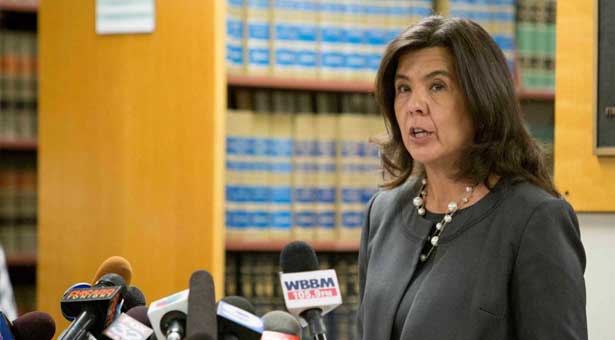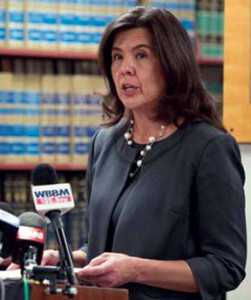
 No charges for Chicago cop in Ronald Johnson shooting death
No charges for Chicago cop in Ronald Johnson shooting death
Cook County State’s Attorney Anita Alvarez speaks at a news conference Dec. 7, 2015, in Chicago where she announced that Chicago police Officer George Hernandez will not be charged in the shooting death of 25-year-old Ronald Johnson.
CHICAGO — Cook County State’s Attorney Anita Alvarez’s decision not to charge a Chicago police officer who fatally shot Ronald Johnson III was made after virtually no independent investigation by her office and despite a police dashboard-camera video that shows Johnson being shot in the back while running from police, the lawyer for Johnson’s family said Monday.
“This is a joke,” attorney Michael Oppenheimer told reporters about an hour after Alvarez laid out her reasons for not charging Officer George Hernandez. “It is the blind leading the blind.”
Alvarez decided against criminal charges because the dash-cam video of the shooting shows Johnson wielding what prosecutors say appears to be a gun.
At a 75-minute news conference, Alvarez tried to sup-port her decision by playing the video, a sample of 911 calls of residents reporting shots fired and recordings of officers calling in updates on police radios of man with a gun.
But Oppenheimer, who in October 2014 filed a federal wrongful death lawsuit on behalf of Johnson’s family, said Alvarez appeared to have relied solely on the flawed investigation done by the Independent Police Review Authority, which investigates police shootings, and never seriously considered charges against the officer.
To bolster that claim, Oppenheimer played a portion of Hernandez’s video-recorded deposition taken a month ago as part of the lawsuit in which the officer says he had never been contacted by Alvarez’s office. The fact that Hernandez freely answered questions under oath for more than six hours indicates he knew he was free of any criminal probe, Oppenheimer said.
“How in the world does he know he’s not going to be indicted unless someone in Alvarez’s office told him?” the attorney said.
Johnson’s mother, Dorothy Holmes, told reporters she was upset with Alvarez’s decision and hoped a special prosecutor would be appointed to do a more thorough investigation.
“I want (Hernandez) charged with murder,” Holmes said.
Alvarez, in the midst of a tough re-election fight, dis-missed claims by Oppenheimer that a gun had been planted by Chicago police at the scene, saying it was unsupported by the evidence.
“All of the evidence points to the fact that Mr. Johnson did indeed have a gun that evening,” she said, including statements from an acquaintance who heard what sounded like a gun being cocked by Johnson and a cartridge case matching the ammunition in Johnson’s gun discovered in the car he was riding in with friends that night.
Alvarez said “a careful analysis of the law” showed that prosecutors could not prove any criminal charges against Hernandez beyond a reasonable doubt. She called Hernandez’s use of deadly force “reasonable and permissible,” citing that Johnson was running toward a police vehicle and a public park on the South Side.
“Police officers are often forced to make split-second judgments in circumstances that are tense, uncertain and rapidly evolving about the a-mount of force that is necessary in any particular situation,” she
said.
To show how such events can quickly turn tragic for police, Alvarez also played a video of an unrelated shooting in which a fleeing suspect had shot and wounded an officer giving chase.
Alvarez said Hernandez was aware of that shooting and referred to it in his statement to investigators from the In-dependent Police Review Authority.
“I’m not covering anything up. I have shown everyone in this room what we have done,” Alvarez said in response to a reporter’s question. “We’re in different times now when we’re talking about transparency and what the public wants to see, and that’s what we’re doing. I have pretty much opened the door here for you to see our entire analysis and the evidence that we looked at and the videos we considered.
“You know, I have a tough job,” she said. “I think I have the hardest job in this county. And I have to make decisions each and every day, each and every day on cases like this … and you know no matter what decision I make, someone is going to be unhappy.”
Oppenheimer, however, continued to maintain that Alvarez was participating in a cover-up by law enforcement that began at the scene the night of the shooting.
The Police Department put out an official statement shortly after the shooting that Johnson had turned and pointed a gun at officers as he ran, prompting Hernandez to fire in fear of his life.
But Oppenheimer said several officers he took depositions from said they were allowed to watch the dash-cam video back at the Area Central police headquarters before any official reports were written. After viewing the video and seeing that Johnson had never turned, detectives filed a case report that day stating that Hernandez feared that “at any moment” Hernandez “could fire shots” at him or other officers on the scene, according to a copy of the report supplied by Oppenheimer on Monday.
Oppenheimer said the report was written in legal language that was clearly tailored to match what was in the video. “This is a cover-up from the beginning,” he said.
Alvarez acknowledged that the dash-cam video of Johnson’s shooting was of poor quality, but she said she believes it shows Johnson holding an object in his hand.
“What we’ve been seeing in these particular cases is they’re not Hollywood-quality videos,” she said. “They’re grainy, it’s dark, it’s blurry, it happens so fast.”
After Johnson fell to the ground, officers saw a weapon in his hand, prosecutors said. The weapon was loaded with 12 rounds. Johnson’s DNA was recovered from the gun and investigators later connected the weapon to a separate shooting from 2013, prosecutors said.
At the news conference, Assistant State’s Attorney Lynn McCarthy said the prosecutor’s office sent the video of Johnson’s shooting to an FBI laboratory to try to establish visual proof that Johnson held a gun in his hand in the seconds before he was shot.
Alvarez said the FBI decided not to take part in the criminal investigation last year after its agents had viewed the video of Johnson being shot twice.
Alvarez also criticized IPRA, saying her office had asked it to question two witnesses in the case in April and only recently heard back on that.
“I do have some concerns about IPRA,” she said.
Johnson, 25, was an occupant in a car that had its window shot out on the night of Oct. 12, 2014. Alvarez said another passenger in that car told police he heard Johnson cock a gun and instruct the driver to head back to where the shots had been fired.
Johnson’s shooting eight days before the killing of Laquan McDonald bore striking similarities to McDonald’s death. The video of 17-year-old McDonald’s slaying, released last month by the order of a Cook County judge, has led to repeated protests that have captured national attention, calls for Alvarez’s resignation and a broader investigation by the U.S. Justice Department of the Chicago Police Department’s use of force.
But one major distinction between the two cases was allegations that Johnson was armed with a gun. Police, who described Johnson as a known gang member, said they recovered a gun at the scene, but Oppenheimer contended that police planted the weapon after shooting an unarmed Johnson.
Police have said Hernandez opened fire only after Johnson pointed a gun at him during a foot chase.
The details about Johnson’s killing have emerged amid continued fallout over the handling of the McDonald case. The Chicago Tribune reported last week that Alvarez’s office was investigating possible criminal charges in Johnson’s case.
Just as it had in McDonald’s shooting, the city had argued in court filings since the shooting 14 months ago that releasing the video would inflame the public and jeopardize the officer’s right to a fair trial if he was charged, court records show. But last Thursday, after a week of mounting pressure for transparency following the release of the video showing McDonald’s shooting, Mayor Rahm Emanuel told reporters he would drop his opposition to making the Johnson video public.
On the night he was killed, Johnson was in a car with friends when the vehicle’s back window was shot out by an unidentified gunman. Chicago police have said that Johnson resisted arrest when officers responded to the call of shots fired and then ran.
During the chase, Hernandez, at the time a tactical officer in the Wentworth Police District, pulled up in an unmarked squad car and jumped out with his gun drawn, Oppenheimer said. The video, which Oppenheimer said he has seen many times, shows that within two seconds of getting out of his car, Hernandez fired five times at Johnson as he was still running away, striking him in the back of the knee and again in the back of the shoulder.
Autopsy results obtained by the Tribune show that the fatal shot traveled through Johnson’s shoulder severed his jugular vein and exited his eye socket.
Oppenheimer said the squad car from which the scene was recorded began to move shortly after Johnson collapsed in the parkway, so the officers’ actions in the immediate aftermath were not captured. Police reported that night that they found a pistol in Johnson’s right hand — a gun that Oppenheimer described as “old and rusty” and completely absent from the video footage.
“There was nothing in his hand, not a gun, a cell phone, a bottle of water — nothing,” he said.
The video was first turned over as part of a wrongful death lawsuit filed by Johnson’s mother a few weeks after the shooting. With that case pending, U.S. District Judge Edmond Chang granted a request by the city for a protective order barring the release of the footage and other sensitive information, records show.
In a separate lawsuit, Holmes’ attorneys have asked a Cook County judge to order the video released under the state’s Freedom of Information Act. Oppenheimer said he hoped that the recent ruling by Chancery Judge Franklin Valderrama ordering the release of the McDonald video — also over the city’s objections — would weigh in his favor.


Be the first to comment